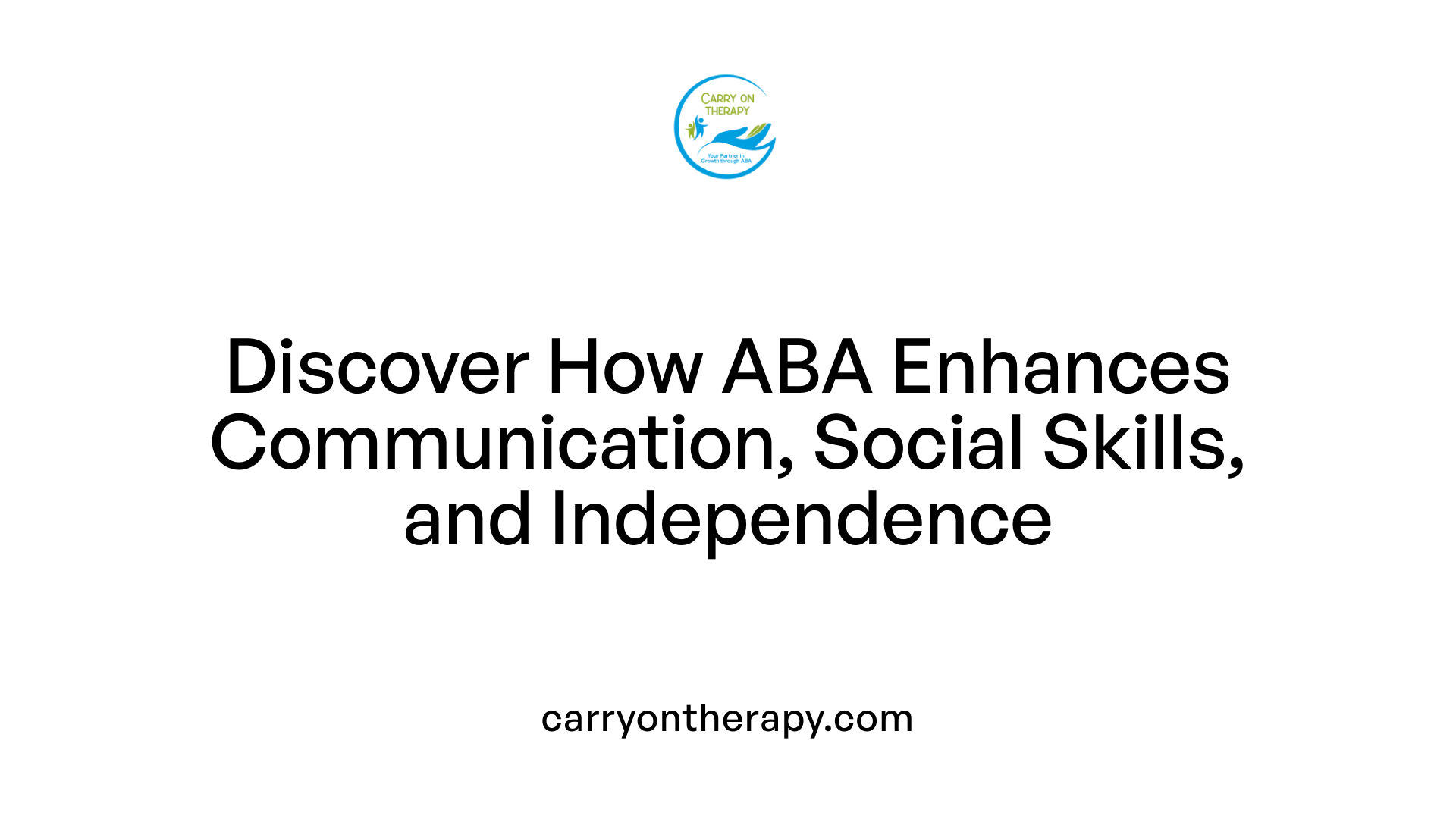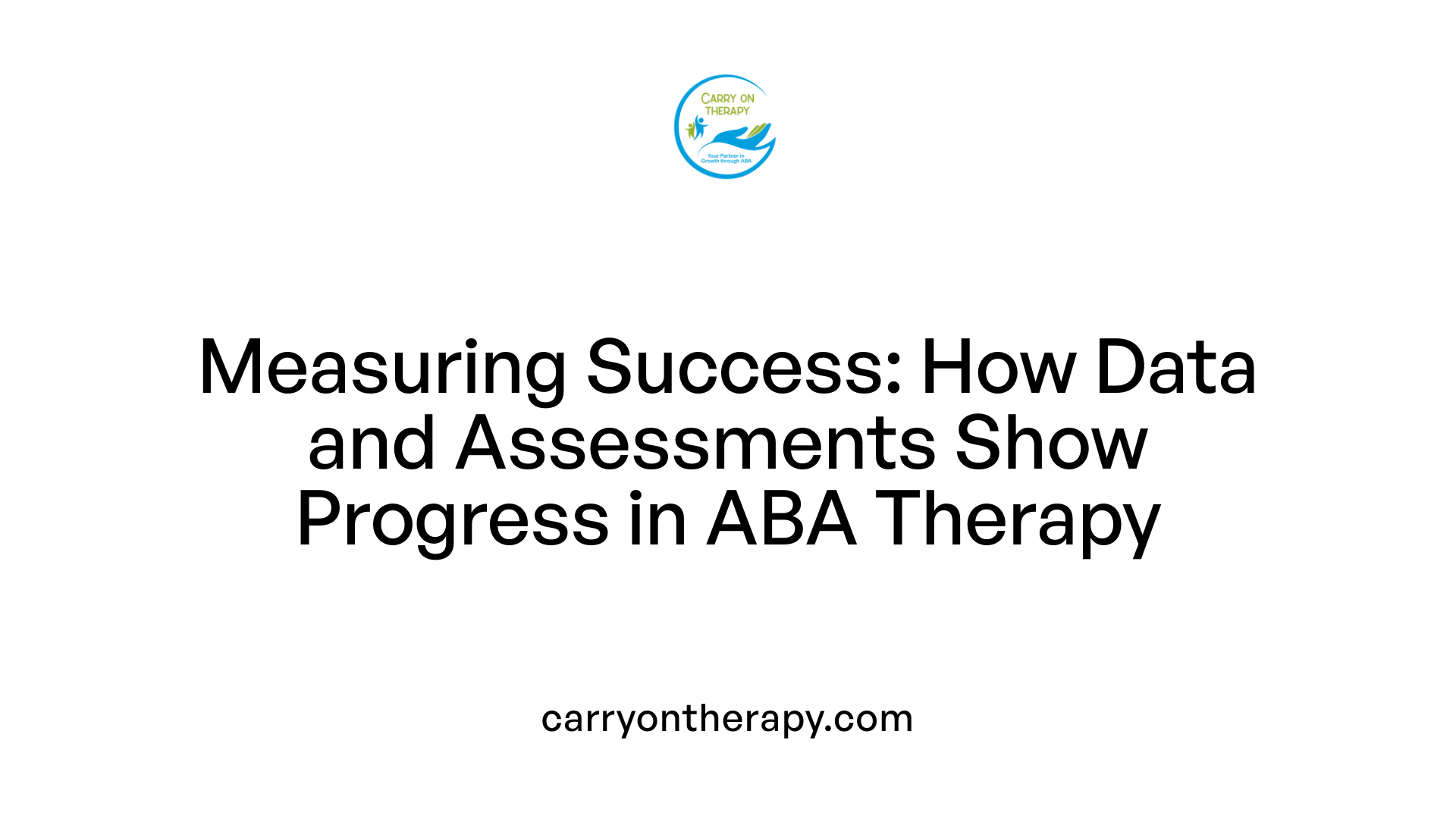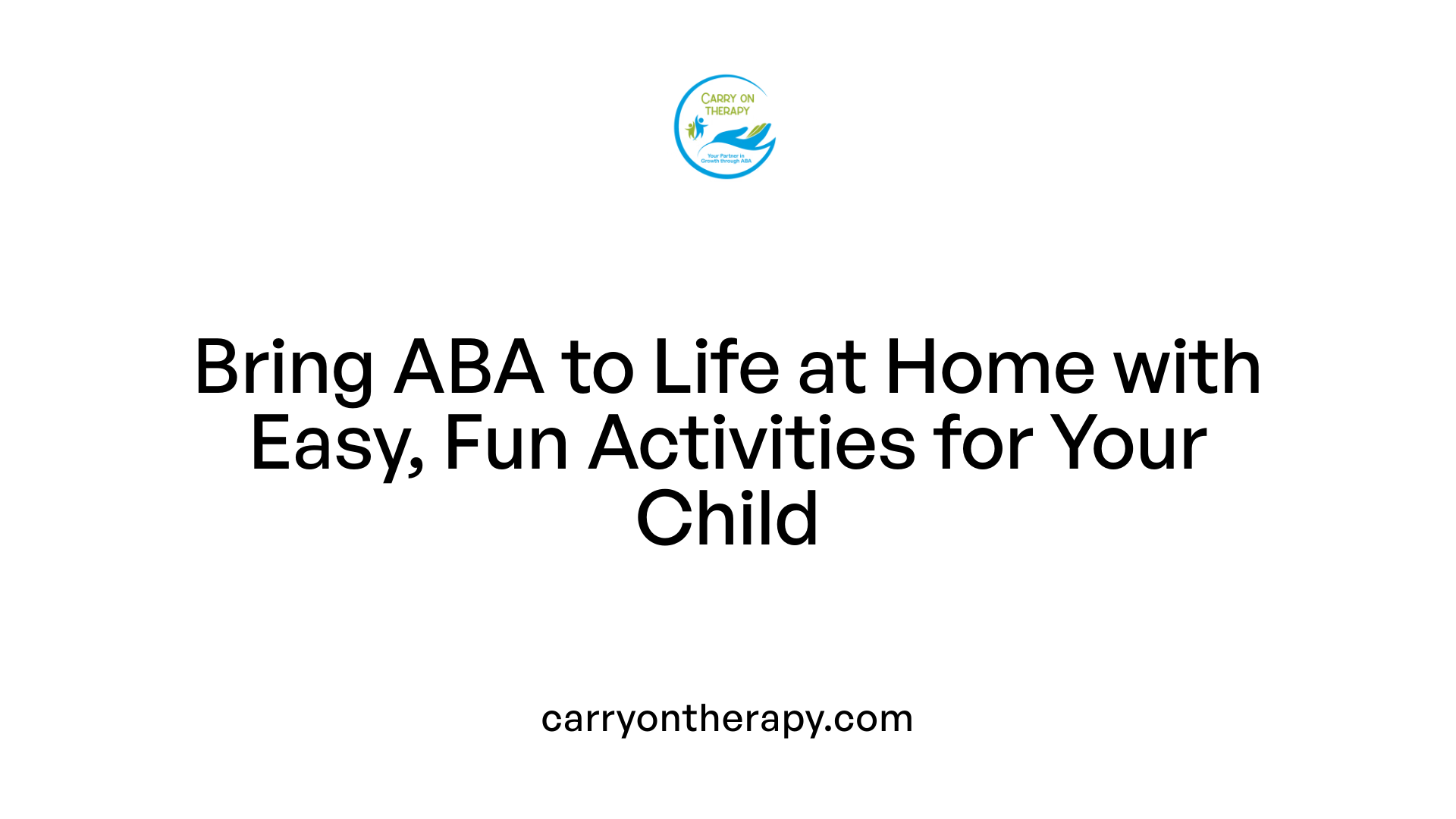Understanding ABA Therapy and Its Role in Autism Support
Applied Behavior Analysis (ABA) therapy is a scientifically validated approach to understanding and shaping behavior, especially effective for children with autism spectrum disorder. By focusing on increasing positive behaviors and reducing challenging ones, ABA therapy helps children develop essential social, communication, and daily living skills. A critical aspect of maximizing ABA's benefits involves parent training, which equips caregivers with the knowledge and skills necessary to implement ABA strategies at home and reinforce learning consistently across environments.
What Is ABA Therapy and How Does It Benefit Children with Autism?

What is Applied Behavior Analysis (ABA) therapy and how does it help individuals with autism?
Applied Behavior Analysis (ABA) therapy is a scientific approach rooted in behavioral science aimed at understanding how behavior works and is shaped by the environment. ABA therapy helps children with autism by increasing helpful behaviors like communication, social skills, and self-care, while decreasing behaviors that interfere with learning or are harmful.
How does ABA work in practice?
ABA relies heavily on principles like positive reinforcement, where desirable behaviors are rewarded with meaningful incentives. Therapists analyze what happens before behaviors (antecedents) and after behaviors (consequences) to modify and teach new skills effectively.
What skills can ABA therapy improve?
ABA programs target many areas, including:
- Language and communication skills
- Attention and focus
- Social interactions
- Memory and academic skills
- Daily living and self-care skills
- Reduction of problem or disruptive behaviors
How is ABA tailored to each child?
Each ABA program is individualized. Qualified Board Certified Behavior Analysts (BCBAs) create personalized goals and design interventions based on detailed assessments of the child's unique strengths and challenges.
Where is ABA therapy delivered?
ABA can be carried out in multiple settings like homes, specialized clinics, or community environments, making it flexible to family needs.
What research supports ABA’s effectiveness?
Since the 1960s, extensive research has shown that ABA is an evidence-based, best-practice treatment for autism. Intensive ABA programs—typically 25 to 40 hours per week over 1 to 3 years—yield improvements in intellectual functioning, language, daily living skills, and social functioning.
ABA therapy is recognized as a powerful tool to help children with autism improve independence and overall quality of life by systematically promoting positive behaviors and reducing barriers to learning.
Who Provides ABA Therapy? The Qualifications Behind Effective Care

Roles of BCBAs
Applied Behavior Analysis (ABA) therapy is primarily delivered by Board Certified Behavior Analysts (BCBAs). These professionals have advanced training and certification in behavior analysis, enabling them to design personalized ABA programs based on detailed assessments. BCBAs set treatment goals tailored to each individual's unique needs and supervise the therapy process.
Training and Certification Requirements
To become a BCBA, individuals must hold at least a master’s degree in applied behavior analysis, psychology, or a related field. They complete supervised clinical experience hours and pass a rigorous certification exam. This ensures a strong foundation in behavioral principles, assessment, and intervention strategies.
Licensure Process and Legal Considerations
Many states require BCBAs to obtain licensure, which involves fulfilling specific education, experience, and examination criteria. For example, in New York State, licensure demands the submission of applications, payment of fees, and compliance with legal regulations, including child abuse prevention training.
Therapists and Registered Behavior Technicians (RBTs)
ABA therapy sessions often involve Registered Behavior Technicians (RBTs) or therapists who work directly with clients under BCBA supervision. RBTs hold certification that requires specialized training and competency in implementing ABA interventions but do not independently design treatment plans.
Professional Education Background
Practitioners typically have academic backgrounds in psychology or behavioral sciences. Those pursuing BCBA certification enhance their expertise through graduate-level coursework and practical experience, ensuring evidence-based, effective care.
Supervisory Relationships within ABA Service Delivery
A collaborative relationship exists between BCBAs and RBTs, where BCBAs oversee therapy implementation, provide ongoing training, and monitor progress, ensuring quality and consistency in treatment.
| Role | Education & Certification | Responsibilities | Supervision |
|---|---|---|---|
| Board Certified Behavior Analyst (BCBA) | Master’s degree + BCBA certification | Assessment, program design, supervision | Oversees RBTs/therapists |
| Registered Behavior Technician (RBT) | High school diploma + RBT certification | Direct therapy implementation | Supervised by BCBAs |
| ABA Therapist | Varies; often bachelor’s or higher; may be RBTs | Conduct therapy sessions under BCBA guidance | Supervised by BCBAs |
ABA Techniques Used to Encourage Positive Behavioral Change
What techniques are commonly used in ABA therapy to support behavioral improvement?
ABA therapy employs several effective methods to promote positive behavioral changes and skill development, particularly for individuals with autism.
Positive Reinforcement is a foundational strategy where desirable behaviors are rewarded with meaningful incentives, encouraging the repetition of such actions.
Prompting and Fading involve providing cues or assistance to initiate a behavior and gradually reducing help as the individual gains independence.
Shaping and Task Analysis break down complex skills into smaller steps, teaching each part progressively to support mastery and confidence.
Visual support tools like Visual Aids and Modeling—using charts, pictures, or videos—help illustrate desired behaviors and facilitate learning.
Behavior Chaining sequences learned tasks together so that completing one step leads to the next, building toward completing intricate activities.
To reduce challenging behaviors, techniques such as Redirection, which shifts attention toward positive alternatives, and Extinction, where reinforcement for negative behaviors is withheld, are implemented.
By combining these evidence-based strategies, ABA therapy effectively enhances communication, independence, and adaptive skills while minimizing problematic behaviors.
Tracking Progress: How the Effectiveness of ABA is Measured

How is the effectiveness of ABA therapy measured over time?
ABA therapy's effectiveness is assessed through systematic data collection focused on the individual's targeted behaviors and skills. Therapists and behavior analysts record observations consistently, using charts and graphs to visualize progress. This objective approach helps identify trends, improvements, or areas needing adjustment.
Behavioral data include frequencies, durations, or intensities of both positive and problematic actions. Visualization tools such as line graphs help stakeholders understand the trajectory of skill acquisition or reduction of challenging behaviors.
Data collection and analysis
Data are gathered continuously during therapy sessions. For example, a child's response to a particular intervention is noted and quantified. Over weeks and months, these data points build a comprehensive picture of development. Data analysis then guides decisions about reinforcing techniques or introducing new strategies.
Using behavioral data and graphs
Graphs play a pivotal role in ABA therapy by providing a clear visual summary of behavior changes over time. They help clinicians quickly assess if interventions are effective or if goals need refinement. This practice ensures therapy is dynamic and responsive to the individual's evolving needs.
Standardized assessments for IQ, language, and adaptive skills
Beyond daily behavioral data, standardized assessments measure broader developmental areas. These include IQ tests, language evaluations (both receptive and expressive), and adaptive behavior scales assessing social skills, communication, and daily living abilities. Progress in these areas validates the long-term impact of ABA.
Measuring parent-led ABA program success
In parent-led ABA interventions, success is similarly monitored through improvements in communication, socialization, and functional skills. Documented gains come from standardized tests and observed behavior changes within home environments. This emphasizes the importance of family involvement in reinforcing therapy goals.
Adjusting therapy based on data
Collected data inform ongoing adaptations in therapy plans. If progress is slower than expected, behavior analysts may tweak reinforcement strategies or target goals differently. Conversely, rapid advancements might allow for shifting focus onto new skill areas, ensuring therapy remains effective and meaningful.
| Aspect | Description | Example/Tool |
|---|---|---|
| Data Collection | Regular recording of behavior frequency, duration, and quality | Session notes, direct observation counts |
| Behavioral Graphs | Visual representation of data to track trends | Line graphs displaying skill acquisition |
| Standardized Assessments | Testing IQ, language, and adaptive behavior | IQ tests, Vineland Adaptive Behavior Scales |
| Parent-led Program Metrics | Assessing home-based progress through observations and tests | Communication benchmarks, social skills checklists |
| Therapy Adjustments | Using data to modify treatment goals or methods | Changing reinforcement schedules or target behaviors |
By rigorously applying these measurement tools and analysis methods, ABA therapy maintains a strong evidence base and personalized approach, maximizing benefits for each individual.
The Vital Role of Parent Training in ABA Therapy
Why is parent involvement important in ABA therapy?
Parent involvement is crucial for the success of ABA therapy because it extends the learning environment from clinical settings to daily life. When parents learn and apply ABA strategies, such as positive reinforcement, they help maintain and generalize their child's progress, ensuring consistent behavior improvement and skill development.
What training formats are available for parents?
Parent training is offered through flexible formats to fit different needs and schedules:
- Online Education: Comprehensive web-based courses like a 10-hour program covering ABA fundamentals and behavior strategies.
- Group Sessions: Interactive group training provides peer support and shared learning.
- Personalized Coaching: One-on-one support with Board Certified Behavior Analysts (BCBAs) guides parents through specific challenges and goals.
What fundamental topics are covered in parent training?
Training typically includes:
- Basics of Applied Behavior Analysis and behavior principles.
- Techniques for positive reinforcement and behavior modification.
- Observation and assessment skills to track progress.
- Practical strategies to reduce tantrums and improve communication.
What are the benefits of parent-led interventions?
When parents are trained to implement ABA techniques, children experience improved communication, reduced challenging behaviors, and better long-term outcomes. Parent-led interventions promote consistency in teaching and reinforce skills across various environments, such as home and community.
How accessible and flexible is parent training?
Parent training is designed to be accessible for busy families. Online platforms allow parents to learn at their own pace without prior ABA experience. Group and individual coaching offer tailored assistance, ensuring that parents can integrate teaching seamlessly into daily routines.
Does insurance cover ABA parent training?
Insurance coverage for parent training varies, but many plans, especially under Medicaid and some private insurers, cover medically necessary treatments prescribed by doctors. This coverage makes ongoing support for families more attainable.
Together, these elements illustrate why parent training is a vital component of effective ABA therapy, empowering families to support their child's development beyond the therapy room.
Implementing ABA Strategies at Home: Practical Activities for Parents

Home-based ABA Activities Parents Can Try
Parents play a vital role in reinforcing ABA techniques beyond clinical settings. Some simple, effective activities include:
- Sit In Chair: Encourages following directions and turn-taking.
- Look At Me: Helps improve eye contact and attention.
- Identify the Emotion: Teaches recognizing feelings, boosting social skills.
These activities focus on foundational social and functional skills crucial for development.
Emphasis on Positive Reinforcement
A core principle in ABA is rewarding desirable behaviors with meaningful incentives. When children are praised or given small rewards during these activities, they are more likely to repeat positive behaviors. This approach increases motivation and helps children retain new skills.
Making Learning Fun and Engaging
Engagement is essential for effective learning. Parents should create an enjoyable environment during ABA activities by including games, toys, or related interests of the child. Fun reinforces participation and encourages consistent practice.
Adjusting ABA Techniques as Needed
Not all strategies work equally for every child. Parents should observe how their child responds and make adjustments to activities accordingly. This might mean changing the reward system, breaking tasks into smaller steps, or altering the pace to best suit the child’s comfort and progress.
Collaboration with Providers
Ongoing communication with behavior analysts and therapists ensures home activities align with professional treatment plans. Parents are encouraged to discuss challenges and successes with providers to receive guidance and maintain effective, consistent ABA practices at home.
Support Systems: Ongoing Clinical Support for Parent Training Success
Group Training Sessions
Group training sessions provide parents with the opportunity to learn ABA strategies alongside others in similar situations. These sessions foster a community environment where experiences and insights are shared, enhancing understanding and application of ABA techniques.
One-on-One Coaching with BCBAs
Personalized coaching from Board Certified Behavior Analysts (BCBAs) allows parents to address specific challenges and receive tailored guidance. This direct support ensures that strategies are effectively implemented and adapted to each child's unique needs.
Ensuring Skill Development and Consistency
Continuous clinical support helps parents develop and refine essential skills over time. Consistent practice, coupled with professional feedback, strengthens parents' ability to use ABA methods effectively, promoting better outcomes for their children.
Building Confidence and Maintaining Motivation
Ongoing encouragement from trained professionals builds parental confidence in applying ABA strategies at home. Regular coaching and group interactions keep motivation high, making it easier to sustain efforts in challenging moments.
Long-Term Developmental Goals for Children with Autism
Support systems focus not only on immediate behavior improvements but also on long-term developmental milestones. By maintaining a collaborative approach, parents and professionals work together to support communication, reduce behavioral issues, and promote overall growth for children with autism.
Accessing ABA and Parent Training: Navigating Insurance and Service Providers
Insurance Coverage for ABA and Parent Training
Insurance coverage for Applied Behavior Analysis (ABA) therapy varies depending on the provider and region. Medically necessary ABA treatments are often covered under Medicaid and some private insurance plans, especially when prescribed by a licensed doctor. Importantly, insurance may also cover ABA parent training, which helps families gain ongoing support in managing their child's autism-related behaviors at home.
Steps to Access ABA Services
Families seeking ABA services should start by consulting with medical providers or pediatricians to discuss their child's needs. Next, they need to verify what ABA treatments and parent training are covered by their insurance policies. After confirming coverage, families can then contact local ABA providers or clinics to schedule evaluations and determine the appropriate individualized therapy plan.
Importance of Medical Consultation and Evaluations
Medical and psychological evaluations are essential to tailor ABA programs to a child's specific needs. Qualified Board Certified Behavior Analysts (BCBAs) perform detailed assessments to create targeted goals and interventions. These professional evaluations ensure that therapy addresses the unique behaviors and skills for each child.
Finding Suitable and Qualified Providers
Selecting providers with appropriate certifications is vital. BCBA professionals design and oversee ABA programs, while Registered Behavior Technicians (RBTs) carry out daily therapy sessions under BCBA supervision. Families should seek providers experienced in autism and with accessible parent training options like those including online courses or in-person coaching.
Affordability and Accessibility Considerations
Many ABA parent training programs are offered online to accommodate busy family schedules and those with no prior ABA experience. Training ranges from brief courses to comprehensive programs and may be free or paid. Insurance reimbursement can improve affordability, making these resources accessible for more families eager to support their children's development effectively.
Enhancing Outcomes Through Empowered Parent Participation
ABA therapy remains one of the most evidence-based approaches to supporting children with autism, with substantial research backing its effectiveness in improving communication, social, and daily living skills. Parent training not only complements professional ABA therapy but also empowers families to apply proven techniques in daily life, reinforcing positive behaviors consistently. By understanding ABA's core principles, engaging in comprehensive parent training, and accessing ongoing support, caregivers become central partners in their child's developmental journey. With increasing accessibility to online training and potential insurance coverage, parents can confidently embrace their role, creating a supportive environment that fosters lasting, meaningful progress for their children.
References
- Applied Behavior Analysis (ABA)
- Parent Training For Online ABA
- ABA Training for Parents: All You Need to Know
- Parent Training in Applied Behavior Analysis Treatment
- NYS Applied Behavior Analysis: License/Certification ...
- How to Become an ABA Therapist - School of Education
- How to Become an Applied Behavior Analyst (ABA) Therapist
- ABA Techniques: Strategies for Behavior Analysts - GSEP Blog
- ABA Therapy Examples, Definition & Techniques
You have to Start to be Great!






